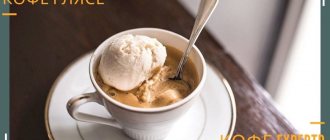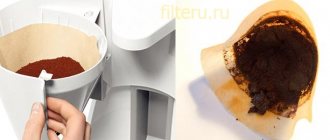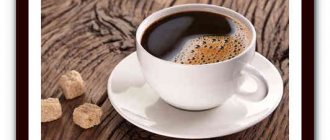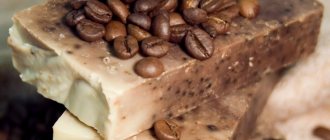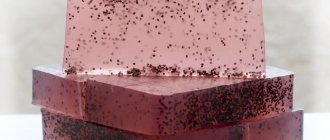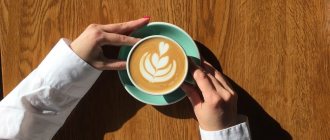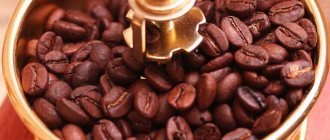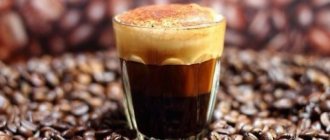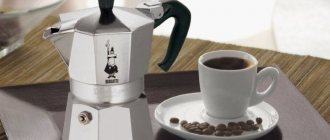Making the perfect espresso is an art that can be learned, it just requires knowledge of the basics and constant practice. In the hands of an experienced barista it looks easy, but in reality creating little coffee perfection is not as easy as it seems. However, if desired, nothing is impossible.
From this article you will learn:
- what types of coffee are suitable for espresso;
- how to grind and dose;
- how to add and compact ground coffee powder before brewing;
- how to properly pour the finished drink into a cup and how to serve it.
CAFFEINE CONTENT: ESPRESSO AND DRIP COFFEE
We all have those acquaintances (we often find ourselves in their place) who come to work in the morning with sleepy eyes and a cup of strong coffee in hand.
When regular drip coffee doesn't cut it, we make a double espresso and start waking up.
Surely one day some coffee lover, yawning tiredly, wondered whether a small cup of espresso really has more caffeine than a regular cup of drip coffee.
It's not that simple, but let's try to figure it out.
Portion size matters
In Italy, the birthplace of espresso, the standard serving size is 25 ml. For most people, this amount of coffee is just a small sip.
To understand why the portions are so small, you need to get acquainted with the espresso drinking culture in Italy. There this drink is consumed throughout the day and, as a rule, after meals. A cup of espresso is something you can drink with friends or in moments of silence, taking a break from the busy rhythm of your work day. However, in other countries, espresso is perceived and drunk a little differently.
For example, in the US, the standard serving size for espresso - called a double shot - is approximately 2 ounces (60 ml) of coffee drink. Many will say that such a small portion of espresso is unlikely to have a stimulating effect. Probably because Americans are accustomed to drinking large portions of drip coffee.
A standard cafe mug or medium-sized coffee cup holds approximately 12 ounces (354 ml) of beverage. The tall tall cup at Starbucks is the second largest cup after the short shot cup, which holds 8 ounces (236 ml) of coffee. So, by drinking 354 ml of drip coffee, you consume almost six times more coffee than a standard 60 ml espresso shot.
However, most people still claim that espresso has a stronger stimulating effect. In some ways they are indeed right, but in general the caffeine content in the final drink will depend on the preparation process and the concentration of the coffee.
Structural formula of caffeine
Coffee making process
The process of making coffee using the drip method involves passing hot water through a layer of ground coffee beans, which are located in a special filter of one kind or another (this prevents small particles from getting into the final drink). Drip coffee makers are very simple and easy to use devices, they are found in almost every home, office, student dormitory, etc.
Espresso differs from drip brewing in that hot water is forced through a layer of ground coffee under very high pressure. Additionally, the coffee beans are ground finer (more on this later). All these factors significantly influence the concentration of the final drink.
Another difference between these two brewing methods is the different ratio of ground coffee to water. In this case, we measure the weight of ground coffee in grams, and the amount of water in milliliters. Essentially, coffee is a drink that is made from two ingredients that are in contact for a certain period of time.
The ratio of these two components when brewing coffee using the drip method can vary, but for most drinks it is approximately 7 g of coffee per 150 ml of water. For standard espresso, the ratio is: 7 g of coffee per 30-60 ml of water. Thus, the concentration of coffee in espresso is significantly higher than in a drink prepared using the drip method. However, on this basis we cannot yet conclude that espresso contains more caffeine.
It's all about the coffee beans
Remember, a regular-sized Starbucks mug or tall glass is 12 ounces of drip drink. According to the ratio of components (see above), this volume should correspond to 16.8 g of coffee. This is twice as much as espresso - a significant difference that cannot be ignored.
Caffeine in its natural state is white and very bitter crystals. It is found naturally in many plants, including two types of coffee trees, from which coffee beans are mainly harvested. As water passes through the ground beans, pleasant flavor and aromatic components are extracted from them, much like steeping tea leaves in hot water. There are many misconceptions about caffeine and its content in the final coffee drink. There are actually three main factors to consider when it comes to coffee strength and caffeine content.
Grinding degree – determines the surface area available for the extraction process. The finer the grind, the more surface area is available for water to pass through the layer of ground beans - this speeds up the extraction process. For different methods of preparing coffee, different degrees of grinding of the beans are recommended. In general, it can be said that a finer grind allows you to extract more flavor and caffeine in a shorter period of time.
Roasting degree . Coffee can be roasted for different lengths of time, which can result in dark, medium, or light roast beans. Contrary to popular belief, roasting beans does not have a significant effect on caffeine content. The different sizes of coffee beans are explained by the fact that during the roasting process they can increase in volume differently. Although the degree of roasting can have a noticeable effect on the taste of the final coffee drink, it does not greatly affect the change in the chemical composition of the beans themselves.
Extraction time is the amount of time a layer of ground coffee is in contact with water. Like tea, coffee can be either over-extracted or under-extracted. If the extraction is too fast, the coffee may be sour and weak. If the extraction takes too long, the drink will taste too bitter.
To create the perfect cup of espresso, coffee connoisseurs prefer to use freshly roasted, evenly ground coffee beans and strive to achieve the optimal extraction time.
Conclusion
It is difficult to determine the exact amount of caffeine in any given coffee drink. However, if we take into account everything that was stated above, we can draw some conclusions.
Regarding espresso : a standard double shot of espresso (2 ounces or 60 ml) should contain 60-100 mg of caffeine.
For drip coffee, an average cup (12 oz or 354 ml) of drip coffee should contain 95-180 mg of caffeine.
On those days when the usual doses of a coffee drink no longer help, it will still be better to drink an increased portion of drip coffee instead of espresso. If this doesn’t work, some recommend a combination of filter coffee and espresso poured into it - in this case, be prepared for the fact that after such a mix you may seem strange to others.
Making classic espresso
There are several factors to consider when preparing this type of coffee. And each barista, after many years of experience, comes to his own, individual technology: some use longer extraction, others experiment with roasting and the type of raw material. But in any case, they all rely on the classic recipe, which contains the basics of making the perfect espresso:
- The extraction lasts 25 seconds. Until you learn how to make espresso with your eyes closed, stick to this interval;
- The amount of ground coffee depends on your portafilter basket. Typically, one standard serving requires 7-10 grams, for a double serving - 16-20 grams;
- The volume of one serving of the finished product is 25-35 ml;
HELP: The amount of water when preparing espresso in a coffee machine does not matter.
A few more important parameters, the observance of which will lead you to the pinnacle of mastery:
- Water pressure. The optimal working pressure is considered to be 8.2-9 atmospheres. To adjust it, prepare a tablet, insert it into the holder and turn on the flow. Pay attention to the monometer and adjust the desired value. During further use, also periodically monitor the numbers on the scale.
- Water temperature . Espresso beans are roasted to a specific temperature, and it is best to adhere to this value. 93 degrees is considered optimal. If the model of your coffee machine does not provide for setting the temperature with an accuracy of a degree, and the adjustment is made with a bolt on the pressure switch, be guided by experience based on the taste of the finished product. Too acidic - we increase the temperature, sharply bitter - we lower it.
- Coffee dosage and portafilter volume . When choosing a basket, give preference to a double one. The extraction is more stable in them. The double basket contains from 16 to 21 grams. ground coffee, depending on its volume. Usually the dosage is indicated on the basket itself and must be strictly followed. If you decide to make a drink from 16 grams of coffee in a basket designed for 21 grams, you will not be happy with the result. If there is no marking, then be guided by the size of the coffee tablet: it should not reach the dispersion mesh slightly.
- Tempering . When making espresso, it is important that the water flows evenly through the entire coffee tablet. To do this, the tablet must be equally dense throughout its entire volume, without lumps, inclusions or voids. Distribute the coffee evenly in the basket and tamp it down with a tamper, avoiding distortion of the tablet. Choose a tamper with a flat base and a diameter close to the size of the basket.
- Extraction . Before installing the holder into the coffee machine, pour 50-100 ml. water. In units with a heat exchanger, this is done in order to reduce the temperature, and in double-boiler units, this is done to clean the mesh from the remnants of previous cooking. Now install the holder and start cooking. The quality standard is considered to be an espresso weighing 36 grams, prepared from 18 grams of ground beans, in 27 seconds at a temperature of 93 degrees. These parameters can be changed depending on the characteristics of a particular coffee machine. IMPORTANT: As soon as you have installed the holder, immediately turn on the pour; a pause at this stage will distort the taste of the finished product, and most likely not for the better.
- Adjusting the taste. Have you prepared espresso following all the recommendations, but its taste is not perfect? There are several ways to correct the situation:
- If the coffee is too sour, increase the yield of the finished drink, increase the temperature or extraction time;
- If there is a lot of bitterness, reduce the yield, reduce the temperature or extraction time.
IMPORTANT: When adjusting the flavor, only change one parameter at a time, otherwise you may overdo it and then have to go back to square one and start over.
Several recipes
Espresso is not only an independent drink with a viscous texture and rich taste. It is also the basis for making many coffee cocktails. In this case, how tasty your cocktail will be directly depends on a well-prepared espresso. Let's prepare the classic and double versions step by step.
Be sure to read: How to make cappuccino with foam without a cappuccino maker
Classical:
- Measure out 7-10 grams of ground coffee.
- Pour into the holder and tamp down.
- Turn on espresso mode.
- The coffee will be ready in 30 seconds.
IMPORTANT: The espresso cup must be hot. Most modern units heat dishes depending on the selected program. If your coffee machine does not have this function, pour boiling water over the cup before starting to brew.
Doppio (double):
Doppio is essentially just a double portion. Therefore, the cooking process does not differ from the classic recipe, but we increase the amount of grain in accordance with the volume of the basket. Usually it is 16-20 gr.
Espresso
“If you don’t have a cup of coffee in the morning... then why get up?”Joseph Brodsky
Today we will talk about real espresso. What it should look like, what it should taste like, what variations of espresso exist.
Espresso is an Italian word. Its original meaning is “squeezed out, compressed.” The most complete meaning can be defined as follows: “this is strong coffee, pressed under high pressure in special espresso machines.” In a matter of seconds, water and steam are forced through the coffee filter under pressure. As a result, about 200 (!) aromatic, tonic and other beneficial substances are extracted from coffee beans. This cannot be achieved in any other way.
Proper espresso has the following characteristics:
— The aroma is uniquely rich, pronounced, with different shades depending on the ratio of Arabica and Robusta, the degree of roasting, and the region where the coffee grows.
— The taste is balanced, rich, enveloping, not sour or bitter, with a long aftertaste.
— The consistency is quite thick.
— The color is absolutely opaque, dark.
— The foam (in the professional language of baristas is called “creama”) is homogeneous, dense, without breaks or large bubbles, reddish-brown (walnut) color with a “tiger texture” (dark specks) along the edges of the cup.
Foam is the most important attribute of good espresso. The height of the foam is 2-3 mm. When running a spoon over the surface, the foam is quickly restored. If there is no foam, it means that the coffee grind was incorrectly selected or the water was supplied with insufficient pressure.
Secrets of making espresso:
— high-quality specialty coffee blends without flavorings. The taste of true espresso does not need to be disguised. You can tell that coffee contains additives by its pronounced non-coffee aroma (usually an imitation of the taste of caramel, Irish cream and almonds), as well as by a strong chemical aftertaste;
— fresh grind for every cup of coffee;
- clean, transparent, never boiled, odorless, soft water (bottled). Under no circumstances should the drink be boiled , as harmful substances may enter the broth (sign: bad taste, unpleasant odor);
— perfect, correctly adjusted grinding (not coarse and not too fine);
- amount of ground coffee - 6-8 grams per serving;
- cooking at a temperature of 85-95 degrees Celsius under a pressure of 9-15 bar. Roasted grain is a living organism and during cooking it cannot withstand water temperatures higher than 96ºC. With this method of preparation under steam pressure, all the most useful substances are extracted from the coffee mixture: aromatic oils, minerals, gluconates, proteins, vitamins, and all the less worthy substances remain in the coffee grounds;
— extraction time (the period of time during which espresso is prepared) — 20-30 seconds;
— the volume of espresso in a cup is no more than 30-35 ml. (in Russia they often serve a larger portion - 50-60 ml.);
— cups made of thick-walled porcelain must be warmed up.
The opportunity to enjoy espresso prepared in the most advanced way possible today is provided only by espresso coffee makers and coffee machines. Coffee machines provide optimal technological conditions for preparing espresso, such as a pressure of 15 bar at a temperature of 88-95 degrees with full automation of the preparation process. All you have to do is press one button. 25 seconds - and you have fragrant espresso in your cup.
Espresso comes in different variations:
espresso solo (“espresso solo” (one serving) - 30 ml. To prepare the drink, 7 g of ground coffee is required. The coffee extraction time in the coffee machine is about 25 seconds.
double espresso (or espresso doppio (doppio) - double portion of espresso solo - 50-60 ml, Use 2 times more ground coffee - 14 g.
ristretto (ristretto) - short espresso, the most concentrated, strongest and most invigorating coffee, brewed in a smaller volume than solo espresso - between 15 and 20 ml. Take 7 g of ground coffee and extract for 15 seconds.
lungo (espresso lungo) - long espresso, has a stronger strength than espresso (due to the higher caffeine content), but has a less rich (more diluted) taste than solo. The same amount of ground coffee is used (7 g), but a larger amount of water (60-70 ml) is passed through it. (extraction time increased by 5-10 seconds).
An Americano is an espresso with added water, but unlike a Lungo, the additional water in an Americano does not pass through the coffee grounds. Therefore, the caffeine content will be the same as in espresso, but its concentration will be significantly reduced. You need to brew a classic espresso from 7 g of coffee without boiling the coffee in the machine for more than 25 seconds! Then it is diluted with water heated to 92 ºС to a volume of 100-120 ml.
corretto - espresso flavored with a few drops of any strong alcoholic drink (cognac, brandy or liqueur).
Romano (translated from Italian as Roman) is a standard shot of espresso with lemon (zest or slice).
How can you ruin an Americano?
In our coffee shops and bars, under the guise of Americano, they very often serve a coffee drink prepared by increasing the coffee extraction time in a coffee machine (the pour lasts not 25 seconds, but 50 or more). This type of Americano is bitter, has a burnt taste, and in addition, it contains substances harmful to the body, including tars and carcinogens. An empty taste with a pronounced sour aftertaste is also a sign of a poorly prepared drink. White spots on the surface of the foam, if any, indicate the presence of excess caffeine in the cup of coffee.
Cup - demitasse, demitasse
The dishes in which coffee drinks are served are also of great importance. To serve espresso, use cups made of thick-walled porcelain (walls at least 5 mm thick), coated with durable enamel, elliptical in shape, truncated inside (egg shape). It is this cup, due to its large heat capacity and unique shape, that makes it possible to appreciate the excellent foam, aroma and softness of drinks. The capacity of the cup for espresso is 65-75 ml, for cappuccino - 120-215 ml. Translated from French, “demitasse” means “half cup”, that is, half of a “regular” coffee cup holding 120-130 ml. Moreover, the cups must be warmed up to 68-74 degrees. To do this, they are placed on the upper heated surface of the coffee machine or heated with hot water or steam.
IMPORTANT! Espresso is “alive” while it is hot. Therefore, to prevent coffee from losing its taste and aroma, it is served in the first 1-1.5 minutes after preparation.

A flight attendant with a low neckline leans towards the passenger and asks:
- What will you drink - tea, coffee?
Passenger:
-Which one contains coffee and which one contains tea?
In the psychiatrist's office.
— Recently, my husband has been acting very strange: after drinking coffee, he eats a porcelain cup, leaving only the handle.
“It’s strange,” says the doctor, “after all, the most delicious thing is the pen.”
